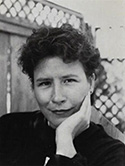Salamander #41 features the winner of their 2015 Fiction Prize, “Floating Garden” by Mary LaChapelle, as well as the 2015 Honorable Mention, “The Hooligan Present” by John Mauk. Judge Andre Dubus III offered these comments on his selections:
 With spare yet deeply evocative prose, “Floating Garden” sweeps us up into the span of a singular life, one that is as sacred as any other, one for whom “the words for things take us from what matters.” This story is a profound meditation on the nature of brutality – of man against man, of man against nature – yet it is also an unsentimental song of how we can be redeemed, “like dust into soil, so dark, so primordial.” This is a lovely gem of a tale.
With spare yet deeply evocative prose, “Floating Garden” sweeps us up into the span of a singular life, one that is as sacred as any other, one for whom “the words for things take us from what matters.” This story is a profound meditation on the nature of brutality – of man against man, of man against nature – yet it is also an unsentimental song of how we can be redeemed, “like dust into soil, so dark, so primordial.” This is a lovely gem of a tale.
 Told in a rollicking, expressionistic voice, “The Hooligan Present” delivers that rarest of reading experiences; it actually makes you laugh, and then it makes you cry, and then it leaves you grateful for such artistry, for such a generous and humane vision of this dirty old world.
Told in a rollicking, expressionistic voice, “The Hooligan Present” delivers that rarest of reading experiences; it actually makes you laugh, and then it makes you cry, and then it leaves you grateful for such artistry, for such a generous and humane vision of this dirty old world.
For a full list of finalists and more information about this annual contest, click here.

 With spare yet deeply evocative prose, “Floating Garden” sweeps us up into the span of a singular life, one that is as sacred as any other, one for whom “the words for things take us from what matters.” This story is a profound meditation on the nature of brutality – of man against man, of man against nature – yet it is also an unsentimental song of how we can be redeemed, “like dust into soil, so dark, so primordial.” This is a lovely gem of a tale.
With spare yet deeply evocative prose, “Floating Garden” sweeps us up into the span of a singular life, one that is as sacred as any other, one for whom “the words for things take us from what matters.” This story is a profound meditation on the nature of brutality – of man against man, of man against nature – yet it is also an unsentimental song of how we can be redeemed, “like dust into soil, so dark, so primordial.” This is a lovely gem of a tale. Told in a rollicking, expressionistic voice, “The Hooligan Present” delivers that rarest of reading experiences; it actually makes you laugh, and then it makes you cry, and then it leaves you grateful for such artistry, for such a generous and humane vision of this dirty old world.
Told in a rollicking, expressionistic voice, “The Hooligan Present” delivers that rarest of reading experiences; it actually makes you laugh, and then it makes you cry, and then it leaves you grateful for such artistry, for such a generous and humane vision of this dirty old world.